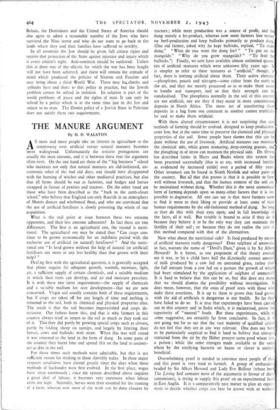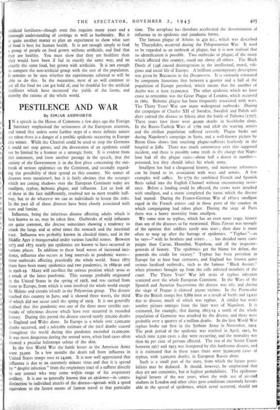THE MANURE ARGUMENT
By H. D. WALSTON
AS more and more people take an interest in agriculture so the controversy over artificial versus natural manures becomes more widespread. Unfortunately the noisiest protagonists are usually the most extreme, and it is between these that the argument often rests. On the one hand are those of the " big business " school who maintain not only that natural manures are old-fashioned, un- economic relics of the bad old days, and should have disappeared with the burning of witches and other mediaeval practices, but also that all farms should be run as factories, and hedges and horses scrapped in favour of prairies and tractors. On the other hand are those who have been described as the " back to the earth-closet school," who believe that England can only flourish in an atmosphere of Morris dances and wholemeal flour, and who are convinced that the use of artificial fertilisers is slowly poisoning the whole of our population. '
What is the real point at issue between these two extreme opponents, and their less extreme adherents? In fact there are two differences. The first is an agricultural one, the second is nutri- tional. The agricultural one may be stated thus " Can crops con- tinue to be grown economically for an indefinite period with the exclusive use of artificial (or natural) fertilisers? " And the nutri- tional one " Is food grown without the help of natural (or artificial) fertilisers any more or any less healthy, than that grown with their help? "
Dealing first with the agricultural question, it is generally accepted that plants require for adequate growth, warmth, moisture, light, air, a sufficient supply of certain chemicals, and a suitable medium in which their roots can develop, and air and moisture percolate. It is with these two latter requirements—the supply of chemicals and a suitable medium for root development—that we are now concerned. Virgin soil usually contains both of these requirements, but if crops are taken off for any length of time and nothing is returned to the soil, both its chemical and physical properties alter. The result is that the soil becomes impoverished and crops de- teriorate. Our fathers knew this, and that is why farmers in this country always tried to return to the soil as much as they took out of it. This they did partly by growing special crops such as clovers, partly by folding sheep on turnips, and largely by littering their horses, cows and bullocks with straw. When this was well rotted it was returned to the land in the form of dung. In some parts of the country they burnt lime and spread this on the land to counter- act aedity in the soil.
.For those times such methods were admirable, but that is not sufficient reason for sticking to them slavishly today. In three major respects conditions have altered greatly since the days when those methods of husbandry were first evolved. In the first place, wages have risen enormously ; since the system described above requires a great deal of labour, it becomes very expensive when labour costs are high. Secondly, horses were then essential for the running of a farm, whereas now most of the work can be done cheaper by tractors ; while meat production was a source of profit, and the dung merely a by-product, whereas now most farmers lose money on beef-production and keep bullocks primarily to produce dung. (One old farmer, asked why he kept bullocks, replied, "To make dung." " What do you want the dung for? " " To put on the mangolds." " Why do you grow mangolds? " "To feed the bullocks.") Finally, we now have available almost unlimited quanti. ties of artificial manures which were unknown fifty years ago. It is simpler to refer to these manures as " artificial," though, in fact, there is nothing artificial about them. Their active elements —phosphates, potash and nitrogen—come either from the earth or the air, and they are merely processed so as to make them easier to handle and transport, and so that their strength can be standardised. The phosphates normally in the soil of this country are not artificial, nor are they if they occur in more concentrated deposits in North Africa. The mere act of transferring thine deposits in a bag from one continent to another cannot truthfully be said to make them artificial.
With these altered circumstances it is not surprising that new methods of farming should be evolved, designed to keep production- costs low, but at the same time to preserve the chemical and physical properties of the soil. Some people have shown that this can be done without the use of livestock. Artificial manures can maintain the chemical side, while green Manuring, deep-rooting grasses, a the ploughing in of straw can maintain the physical side. Dr. Orwiu has described farms in Herts and Bucks where this system has been practised successfully (that is to say, with increased fertility as evidenced by increased yields) over a period of fifty years. Other instance can be found in North Norfolk and other parts of the country. But all that this proves is that it is possible to farm well without livestock, and that the humus content of the soil can be maintained without dung. Whether this is the most economical form of farming depends upon so many.other factors that it is im- possible to dogmatise. All one can say is that most farmers seem to find it more to their liking to provide at least some of their humus requirements by the old-fashioned method of dung. So long as they do this with their eyes open, and in full knowledge of the facts, all is well. But trouble is bound to arise if they do it because they believe it to be the only way they can maintain the fertility of their soil ; or because they do not realise the cost of this method compared with that of the alternatives.
Now what about the nutritional side? Is food produced by means of artificial manures really dangerous? Does sulphate of ammonia, in fact, warrant the name of " Devil's Dust," given it by Sir Albert Howard? Is it better, as one proponent of this theory assured me it was, to let a child have half the dietetically correct amount of milk produced by a cow fed on untreated grass, rather than the full amount from a cow fed on a pasture the growth of which had been stimulated by the application of sulphate of ammonia? It is hard to believe that this can be so, but this does not mean that we should dismiss the possibility without investigation. It does mean, however, that the onus of proof rests with those who make these assertions. It is up to them to prove that food grown with the aid of artificials is dangerous to our health. $o far they have failed to do so. It is true that experimegts have been carried out in this country and in India which, it is maintained, prove the superiority of" natural" foods. But these experiments, while to some suggestive, are certainly far from conclusive. In fact, it is not going too far to say that the vast majority of qualified critics do not feel that they are in any way relevant. One does not have to be particularly sceptical to find it hard to believe that nitrogen extracted from the air by the Haber process turns good wheat into a poison ; while the same nitrogen made available to the same wheat by the nitrifying bacteria on beans or clover is entirely beneficial.
Overwhelming proof is needed to convince most people ((this, and this proof is very hard to furnish. A group of enthusiasts, headed by Sir Albert Howard and Lady Eve Balfour (whose book The Living Soil contains most of the arguments in favour of these contentions), is trying to supply this proof on an experimental farm in East Anglia_ It is a comparatively easy matter to plan an experi- ment to decide whether crops can best be grown with or without artificial fertilisers—though even this requires many years and a thorough understanding of costings as well as husbandry. But it is quite another matter to plan an experiment to show what sort of food is best for human health. It is not enough simply to feed a group of people on food grown without artificials, and find that they are healthy. You must show that they are healthier than they would have been if fed in exactly the same way, and on exactly the same food, but grown with artificials. It is not enough to compare the non-artificial group with the rest of the population. It remains to be seen whether the experiments referred to will be able to do this. In the meantime, most of us will continue to eat all the food we can get hold of, and be thankful for the artificial fertilisers which have increased the yields of the farms, and thereby the rations of the whole world.































 Previous page
Previous page